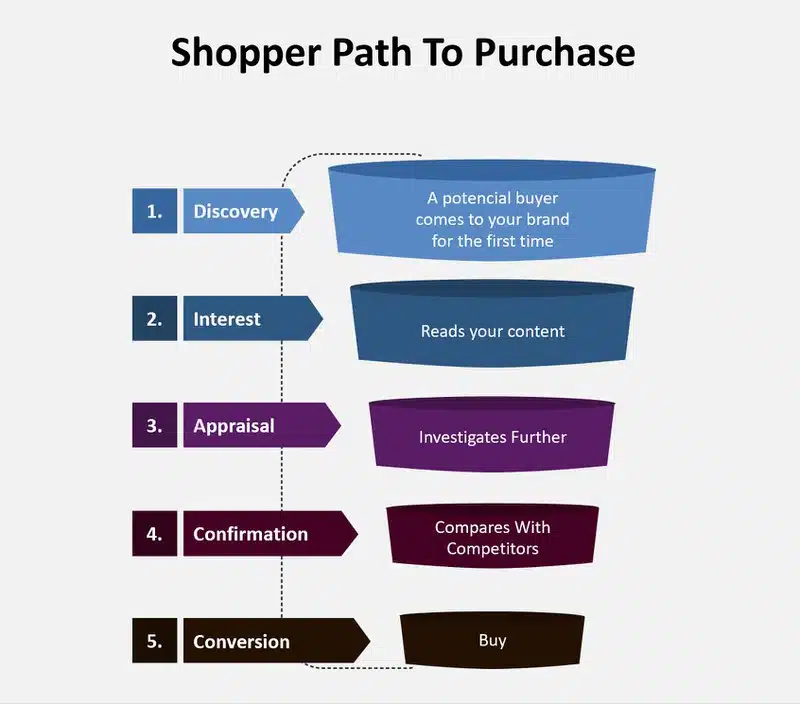Shopper marketing has become an increasingly important tool for businesses seeking revenue increase with less investment. Traditionally, marketers have focused on targeting consumers through traditional television, radio, print, and digital channels. However, with the rise of the digital age, shoppers are using more online channels than ever to find what they need and make purchasing decisions.
That’s why shopper marketing has become so important. It allows businesses to reach shoppers directly, giving them the information they need to make the right decisions and drive more significant sales.
In this article, we’ll explore the essential elements of shopper marketing, including the types of strategies businesses can deploy, the benefits of incorporating shopper marketing into their marketing mix, and how you can use shopper marketing to increase revenue.
So, if you’re looking to capitalize on this growing trend and take your business to the next level, read on to learn more about the key to unlocking significant revenue.
What Is Shopper Marketing?
Shopper marketing is a strategy businesses use to increase the profitability of their products or services by targeting shoppers directly. This involves reaching out to shoppers already in the market for a product or service and providing them with the information they need to make an educated purchasing decision.
Shopper marketing is often combined with traditional marketing techniques such as television, radio, print, and digital advertising. However, it goes beyond traditional marketing by providing more detailed information shoppers need to make informed decisions.
Additionally, shopper marketing helps to drive loyalty among customers by providing them with special offers and deals. It can be a great way to build customer relationships and encourage repeat business.
In addition, shopper marketing can help businesses learn more about their customers and tailor their marketing strategies to meet their needs better. By understanding their shoppers, brands can effectively target their most profitable customers and create offers that resonate with them.
Overall, shopper marketing is a powerful tool for businesses that enables them to reach shoppers directly and drive increased sales. By understanding their shoppers and providing them with the information they need to make informed purchases, businesses can better target their most profitable customers to build long-term relationships with them.
What is the Shopper Marketing funnel (or the shopper’s journey)?
Shopping marketing is a powerful tool for businesses to reach their target customers. It involves creating campaigns to increase brand awareness, drive sales, and build customer loyalty. It also uses various channels, including search engine optimization, email campaigns, social media, and content marketing.
This type of marketing is a highly effective way for businesses to reach shoppers directly and influence their buying decisions. By utilizing targeted messaging and campaigns, companies can tap into the power of the shopper to maximize their sales at each step of the purchase path.
Shopper marketing works by understanding the shopper’s needs and preferences, then creating campaigns and content tailored to their specific interests.
The shopper’s journey starts when they become aware of a product or service and ends when they make the purchase decision.
That journey can involve:
- Researching online
- Visiting a store,
- Engaging with a brand’s marketing materials in various mediums such as print, digital, in-store, and social media.
With shopper marketing, brands can identify the critical moments along the shopper’s journey and engage with them at those points. It allows them to connect with shoppers at the right time and place.

For example, as a business, you can use segmented email campaigns to target buyers in the discovery or consideration process, making them aware of your product and brand.
Next, you can work to produce listicles (the 10-best or the ten highest quality products or services in your niche). After they are created, you can guest post them on high-traffic websites, which can help them compare and reduce their purchase options in the appraisal process.
With SEM or targeted ads, you can get them when they are looking for your product to confirm their opinion until the conversion.
Ultimately, shopper marketing is an innovative way for businesses to maximize their sales and get the most out of their marketing efforts. Shopper marketing has the potential to improve businesses’ bottom lines significantly and is quickly becoming a crucial part of successful marketing strategies.
Shopper Marketing Tactics
Businesses can target shoppers looking for a specific item by running targeted ads, creating in-store promotions, providing discounts, and creating loyalty programs. These tactics help companies to build a connection with shoppers and increase their chances of conversions.
Shopper marketing tactics have the potential to drive up revenue and increase customer loyalty. By understanding and connecting with shoppers, businesses can create relationships that last. This helps to strengthen the brand and build customer loyalty, which can lead to more sales.
Additionally, shopper marketing helps reduce marketing costs as businesses can target specific shoppers instead of a broad audience. This can result in a higher return on investment.
Let’s see some o the most common tactics.
Affiliate Marketing
Affiliate marketing involves a publisher (affiliate) promoting another company’s product or service and receiving a commission for each successful sale.
Affiliates are usually paid in one of two ways: cost per click (CPC) or cost per acquisition (CPA). CPC means the affiliate earns money when someone clicks through to the merchant's website, while CPA requires the affiliate to generate a sale before they get paid. Affiliates are sometimes compensated through revenue sharing, which means they earn a percentage of any profits from their promotions.
SEO
Search engine optimization (SEO) is a type of marketing that focuses on optimizing websites for higher organic search engine rankings. This helps businesses appear higher on search engine results pages when customers search for products or services related to the company.
SEM
Search engine marketing (SEM) is an online marketing strategy businesses use to increase visibility, traffic, and sales. It involves optimizing website content to rank highly in search engine results pages (SERPs). With SEM, businesses can create ads that appear in SERP for specific keywords related to their products or services.
SEM offers several advantages over other forms of digital marketing. It can provide a high return on investment (ROI), especially when targeting users already looking for the products or services offered. It also allows businesses to target specific audiences based on age, location, and interests. Additionally, since SEM campaigns are tracked with analytics tools, businesses can optimize their campaigns more efficiently and effectively than with other types of digital marketing techniques.
Email Marketing
Email campaigns are another way to reach customers; businesses can send emails with offers, coupons, and other promotions to generate interest in their products or services.
Email marketing refers to using email as a promotional tool for businesses. It is one of the most effective digital marketing strategies available today and allows companies to reach their customers directly. Email marketing allows businesses to build relationships with their customers, target audiences, and potential buyers to increase brand awareness and loyalty.
With email marketing, companies can send out personalized messages tailored to each customer's needs or preferences. This helps create more relevant connections between the business and its customers. Additionally, when done correctly, email marketing can help increase sales by providing discounts or promotions that entice the recipient into making a purchase.
Overall, email marketing is a highly efficient way for businesses to connect with their target audience and effectively promote their products or services.
Social Media
Social media can also promote products or services; businesses can post content on platforms such as Twitter, Facebook, Instagram, and YouTube to reach potential customers.
They are a great source for retargeting due to the reach and engagement they have among different groups of consumers.
Content Marketing
Finally, content marketing focuses on creating and distributing content such as blog posts, videos, e-books, and infographics to attract and engage customers.
It helps businesses create campaigns tailored to their customers' interests while also increasing awareness of their products or services.
Other Tactics
Brands may also implement in-store displays, shelf talkers, coupons and discounts, loyalty programs, and many other tactics.
How to Create a Shopper Marketing Strategy?
Creating a successful shopper marketing strategy starts with understanding the customer journey. Knowing the purchase cycle that shoppers go through will help you target them more effectively.
By understanding the shopper’s journey and crafting a well-thought-out strategy, businesses can maximize their reach and convert shoppers into loyal customers.
Shopper marketing can be an effective tool for businesses looking to increase their revenue and gain market share. Let’s see some points of a shopper marketing strategy.
Understand Shopper’s Needs
By understanding shoppers’ needs and motivations, businesses can create campaigns to reach them in the right place and at the right time. This includes segmentation, personalization, and targeting techniques to ensure the right message is sent to the right people.
It is essential to understand who the shoppers are, their needs, and what channels they use to make decisions. This information can be gathered through research, surveys, or analytics tools.
Once you understand the shopper's journey, you can begin crafting a strategy that meets their needs.
Integrate Data
Additionally, integrating data from online and offline sources can help create a more comprehensive shopper marketing strategy.
Create Tailored Experiences
By leveraging the right technology, businesses can create shopper experiences tailored to the individual, making them more likely to purchase. It can include things like:
- Personalized recommendations
- Targeted promotions
- Customized offers.
Create Engaging Content
A good shopper marketing strategy includes developing engaging content that resonates with shoppers, offering discounts or incentives to drive purchases, and using various marketing channels such as online, in-store, and mobile to reach them. It’s also essential to use segmentation to ensure that you’re targeting the right shoppers at the right time.
Leverage Insights
Additionally, by leveraging insights from analytics, businesses can optimize their shopper marketing efforts to maximize their impact. This can include:
- Optimizing promotions
- Leveraging loyalty programs
- Providing shoppers with timely offers.
By considering these factors, businesses can create effective shopper marketing campaigns that drive higher sales and greater customer loyalty.
Bottom Line
Shopper marketing is an increasingly powerful tool for businesses to drive sales and unlock considerable revenue. By using a combination of traditional and digital marketing channels, businesses can target shoppers directly and effectively.
With shopper marketing, companies can target shoppers at different stages of the buying process, providing them with the information they need to make the right purchasing decisions. This allows companies to create a personalized and tailored experience for shoppers, increasing engagement and establishing trust.
In the future, shopper marketing strategies will likely become even more personalized and sophisticated. With access to more sophisticated data and analytics, businesses can gain a deeper understanding of their target shoppers, allowing them to create more tailored experiences.
Additionally, augmented reality, virtual reality, and artificial intelligence may be used to make even more immersive and engaging experiences. As shopper marketing evolves, businesses will have more opportunities to drive significant revenue.

Christian has over ten years of experience in marketing agencies. Currently, he has been dedicating his time to a tech startup and also writing for major publications. He loves podcasts and reading to keep up with the latest trends in marketing.
